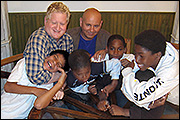UU dads adopt five at-risk children
New documentary focuses on the Rev. Greg Stewart, Stillman Stewart, and their five sons
In one of the opening scenes of the documentary film Preacher’s Sons, Stillman Stewart sits by a Los Angeles pool with his husband, Greg Stewart. The two white men watch their sons, splashing in the water, five boys of color who call out “Papa” and “Daddy” to Stillman and Greg. Stillman laughs, and recounts a conversation he’s just overheard between two older women at the pool who were observing their family. “Uh-oh,” one woman said. “There must be something wrong here.”
Preacher’s Sons follows the untraditional Stewart family for five years, through four cities. Despite what the women by the pool thought, the film depicts the Stewarts as doing something very right—giving permanent, loving homes to at-risk, hard-to-place children lost in the foster care system.Between 2000 and 2002, the Rev. Greg Stewart, senior minister of the First Unitarian Universalist Society of San Francisco, and Stillman Stewart, a former social worker and now at-home parent, adopted five sons through the California foster care system. Their story attracted the attention of several television networks, which approached them about filming their family. The Stewarts always refused these requests. Things changed, however, when they were approached by two members of the Neighborhood Unitarian Universalist Church in Pasadena, Calif., where Greg was serving as minister of religious education. The Stewarts didn’t believe the networks shared their mission of promoting the adoption of at-risk children. However they trusted fellow church members and husband-and-wife filmmakers Mark Nealey and C Roebuck Reed.
“We knew we had a very special story, but the reason we share it is to expose people to the foster care crisis in America and to encourage people of liberal faith to act on their beliefs,” said Greg. “We want them to consider adoption or foster care or some other way to inject themselves into a child’s life.” More than 510,000 children are in foster care in the United States, according to the U. S. Department of Health and Human Services, and more than 120,000 children await adoptions.
Nealey and Reed began filming the Stewart family in 2002. Nealey’s background was in film editing and directing; Reed is a writer trained as a cultural anthropologist. “This was my dream—to do an ethnographic-style documentary,” said Reed. “We knew it was going to be a good story. But they also turned out to be fabulous parents.”
Greg Stewart describes their decision to become involved in the lives of at-risk children as a calling. While in divinity school at the University of Chicago, he served an internship at Chicago’s Second Unitarian Church, while Stillman worked as a social worker with at-risk youth. (He was known as Stillman White until he changed his name to Stewart after his marriage to Greg in 2008.) They began to bring children from Chicago group homes to church services with them on Sundays, and the congregation of Second Unitarian began to embrace and engage these children. “As I worked in church and Stillman in social work and our worlds collided, we felt called to do something more with kids caught in the foster-care system,” said Greg.
They next moved to Ohio and looked into adopting there. Though Ohio law doesn’t bar gay couples from adopting—as do the laws of several U.S. states, including Florida and Utah—the Stewarts found that social workers were wary of placing children with them. After they moved to Los Angeles, they found a social worker who was willing to give them a try. The Stewarts said that they would adopt any race, color, or gender, and that they were specifically interested in providing a home to children who were hard to place.
The film recounts how each boy came to Greg and Stillman between 2000 and 2002. First came Allen, a 3-year-old African American. He’d been born three weeks premature, with fetal alcohol syndrome and a cocaine addiction, and he’d been moving from foster home to foster home his entire short life.
David came next. Allen’s biological brother, he’d been abandoned at the hospital after birth. He joined the Stewart family at 2.5 weeks.
At nearly the same time David joined them, Arthur came, too, aged 7. A Latino boy, Arthur had 15 previous foster placements and three failed adoptions, as well as a history of abuse and neglect. At age 9 in Preacher’s Sons, he spoke on camera about his family. Arthur said, “My dads are so nice. They just take care of me and protect me. And they’re now my real fathers. It’s like I came out of their stomach. And I like it right here. It’s fun.”
Then another pair of brothers arrived. Javonte, 7, and Dionte, 6, had been in 12 previous placements. The social worker warned Greg and Stillman that, with these boys, they’d be moving to a new level. Neither boy was toilet trained or could use silverware to eat. Not accustomed to regular meals, they would hoard food, taking it to their rooms and hiding it for later.
As they filmed, Nealey and Reed watched the family come together and saw the children change. “You can see the transformation of the children unfold before your eyes,” said Reed. “That is the power of love. That is what the film shows.”
Reed released Preacher’s Sons in the summer of 2009.
Nealey had completed the editing of the film in late 2007, but four months after finishing the film, he died of a recurrence of cancer. After his death, Reed said, she went into a tailspin.
Reed put the release and distribution of the film on hold, while she and her adult daughters, Maia Nealey Reed and Riva Nealey Reed, who also worked on the film, grieved over Nealey’s death. This past July, she left her California house, bought a used motor home and headed alone to Montana and South Dakota on a self-guided spiritual retreat. “I needed to figure out my next act,” she said.
Reed decided to launch a grassroots effort to promote the film. She contacted the Rev. Dr. Lee Barker. Now president of Meadville Lombard Theological School, Barker had been minister of the Pasadena church when Reed’s family joined, and he had acted as an advisor on the film. Barker wrote a letter of recommendation for the film to ministers in areas Reed planned to tour. And this fall, she began a road trip to screen the film and conduct workshops about it. She allows churches to show the film for free if they allow her to come and sell it on DVD.
Reed has also screened the film at colleges and universities. For example, she showed Preacher’s Sons in three parts at an occupational therapy class at the University of Southern California. Students watched as the film depicted the family moving to Greg’s new jobs—going from Los Angeles, to Grand Rapids, Mich., to Reno, Nev., and finally to San Francisco. Reed watched as students who were initially opposed to gay adoptions began to soften their positions. One told her: “I know my pastor still says it’s a sin, but you have to admit, these kids are doing really well.”
Reed also has prepared a program for social workers who work with same-sex couples preparing for foster care and adoption. She offers them a training program and study guide.
Churches or groups interested in having a screening of Preacher’s Sons can contact Reed through the film’s website, www.preacherssons.com.
Stillman and Greg Stewart have watched the film with their family, both at home and at a public screening in Pasadena. The movie was also recently featured on a November segment of “In the Life,” a PBS series that explores GLBT issues. To his family, Greg says, Preacher’s Sons is more than a film. “It’s a testimony that if you’re open to possibility and have a faith that says ‘yes’ more than it says ‘no,’ great things can happen.”
“We certainly didn’t start out with this grand scheme,” Greg continues. “A need was put before us that we could meet, and we chose to say yes. That’s where the real power in a spiritual life is—being able to say yes.”
The oldest of the Stewart boys, Arthur, is now 17. David, their youngest, is 9. Greg and Stillman envision that in the future, when some of the boys are at college and there is more room in their home, they’ll adopt again.
Greg Stewart believes that the film has raised awareness of the need for foster care and adoptions. Since the release of Preacher’s Sons, he has received calls and emails from people who are beginning to have home studies in order to become foster or adoptive parents. And he’s heard from others who have decided to volunteer in after-school programs or tutoring services for at-risk youth.
“The movie has brought a sense of urgency to the situation, along with a call for a liberal religious response,” Greg said.
See sidebar for additional resources.








